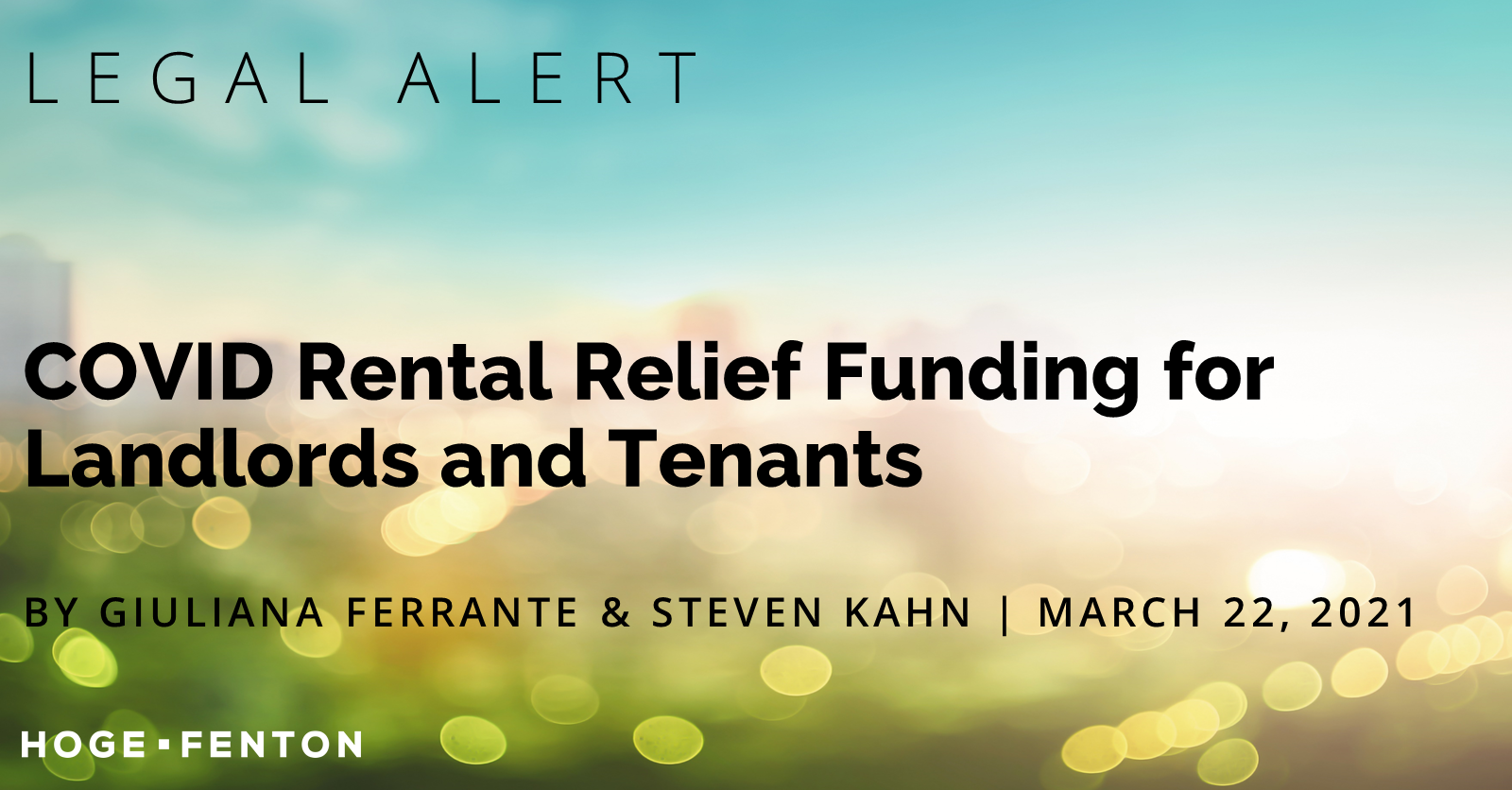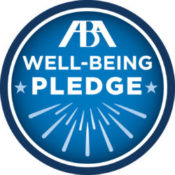COVID Rental Relief Funding for Landlords and Tenants
By Hoge Fenton | 03.22.2021 | Firm Post

In a coordinated effort between the federal government, the State of California, and local jurisdictions, tenants and landlords can now apply for rental assistance. This is excellent news for all. The funds are intended to mitigate debt owed to landlords by residential tenants who remained housed but did not pay some or all of their rent due to COVID-related hardships, as provided by eviction protections laws.
This article discusses:
- Program Overview
- Who is Eligible
- How to Apply
- Expenses that Qualify for Reimbursement
- Landlord-Tenant Cooperation on Applications
- Additional Applications
Program Overview
Pursuant to Senate Bill 91 (“SB-91”), the State of California and various local jurisdictions implemented an application process for landlords and tenants to receive reimbursement funding for up to 80% of the missed rent owed during the April 1, 2020, and March 31, 2021 time period.
In exchange for the 80% in reimbursement, landlords must agree to waive their rights to collect the remaining 20% and must promise not to sue their tenants for this 20% remainder.
Landlord participation in this program is optional. If a landlord does not participate in the Rental Assistance Program, tenants can still apply and participate and the State will pay them amounts equal to 25% of their back-owed rent.
While the Rental Assistance Program is optional, if landlords later sue the tenant for damages based on the tenant’s rental arrears without participating, judges in those cases do have the discretion to make a finding on how much the landlord’s requested rent was available to the landlord via the Program and could reduce the landlord’s damages based on the funding available via this program.
An important consideration for landlords:
Those who choose not to participate in the Rental Assistance Program, and later sue tenants for nonpayment of rent damages, risk reduced recovery. This is because judges in those cases have the discretion to reduce the landlord’s damages by the amount of rent recovery available to, but declined by, the landlord.
Where to Begin?
The State of California’s “Housing is Key” website should be the starting point for applications. Depending on the jurisdiction, applicants should either apply through the State of California or through a local jurisdiction’s process. The website directs applicants to the appropriate application for their jurisdiction.
The State will prioritize funding for tenants who suffer the most vulnerability to homelessness, focusing first on households earning less than 50% of their Area Media Income, then on households disproportionately impacted by COVID-19, and then on all households earning less than 80% of the Area Media Income (AMI).
Please note that some jurisdictions, such as San Francisco County, received federal funding to implement their own programs separately from the State of California. Other jurisdictions may choose to implement their own programs, rather than administering it through the State of California. Applicants in these jurisdictions are cautioned to expect delays in receipt of funding while officials work to avoid duplicative payments.
Who is Eligible to Apply?
Both landlords and tenants are eligible to apply, however, there are different criteria for each.
Landlord Eligibility Requirements:
- All payments must be used to satisfy tenants’ unpaid rent for the period between April 1, 2020, and March 31, 2021.
- Tenants must take steps to verify that they meet eligibility requirements and sign the application.
- Tenants’ household income must be at or below 80% of the Area Median Income.
- Tenants must certify that they have not defaulted in any way under their lease or rental agreement, other than the nonpayment of rent.
- Tenants must also promise to resume making rental and utility payments starting on the first dates after those covered under the program, or to reapply for the rental assistance program for more assistance.
Importantly, the application requires that landlords wait at least 60 days after the last month the landlord received funding before the landlord can file a lawsuit for any future nonpayment of rent or nonrenewal of the lease. For example, if a landlord participates in the Rental Assistance Program and receives funding amounting to 80% of rental arrears due from April 1, 2020, through March 31, 2021, the landlord must wait until at least May 31, 2021, to file a suit in unlawful detainer or damages for the nonpayment of rent for the April 2021 or May 2021 time period.
The landlord must also agree:
- That the landlord knows of no reason, except nonpayment of rent, that would justify a lawsuit for unlawful detainer or damages.
- Not to evict the tenant for any nonpayment of rent owed before April 1, 2020.
Note that landlords may sue for nonpayment of rent damages starting July 1, 2021, so long as tenants who have COVID-19 related hardships timely provide a declaration certifying they have financial distress for each rental period.
Useful Resources for Landlords
Tenant Eligibility Requirements:
- Have qualified for unemployment benefits or experienced a reduction in household income, incurred significant costs, or experienced other financial hardship due to COVID–19.
- Demonstrate a risk of experiencing homelessness or housing instability, which may include: (a) a past-due utility or rent notice or eviction notice; (b) unsafe or unhealthy living conditions; or (c) any other evidence of such risk, as determined by the program.
- Have a household income that is not more than 80% of the Area Median Income. The online Rental Assistance Application calculates this for the applicant.
Useful Resources for Tenants:
How to Apply for the Program
Landlords and tenants can apply online via the Housing is Key website.
Applicants can also apply via phone at (833) 430-2122 from 7:00 AM – 7:00 PM Pacific time Monday through Sunday.
Applicants may apply through Local Partner Networks: organizations in several local communities who can schedule appointments or home visits (in limited circumstances, such as an applicant having a disability) with applicants who need hands-on assistance.
Expenses that Qualify for Reimbursement
The 80% reimbursement will include more than just rent; other reimbursable expenses include utilities owed and incidental charges such as parking if the tenants were required to pay these costs under their rental agreements.
While the State will directly pay the reimbursement for missed rent to landlords, California designates tenants as the “benefitted” party, and payments received under this funding must be applied to that tenant’s back-owed rent.
Cooperation Between Landlord and Tenant Applicants
The State encourages landlords and tenants to cooperate on the application so that the greatest amount of eligible applicants can be served, as this is the best chance for parties to meet their outstanding rent obligations. Without tenant participation, the State cannot verify the “need” which makes the tenant eligible for assistance.
Tenants who submit their application will receive a reference number to send to their landlords to integrate the application. Similarly, landlords who submit their application will also receive a reference number to send to tenants for use in their applications.
Each party will be able to privately submit their supporting documents without the other having access, including w9s for landlords and proof of financial distress for tenants.
Will additional applications be available for local jurisdictions?
Some jurisdictions, such as the City of Los Angeles, San Francisco City, and County, and Sacramento are administering their own rental assistance program separate from the State of California’s. The local programs may not yet be available.
Organizations including the California Apartment Association and the National Low Income Housing Coalition created handy guides to assist program applicants:
Will there be additional funding and programs in the future?
Funding for the current rental assistance program comes from the $2.6 billion in federal rental assistance allocated to California in December of 2020. Now that President Biden signed a new stimulus package, the American Rescue Plan, in March of 2021, Californians can soon expect more federal rental assistance to come from an additional $2.2 billion in emergency federal funds.
Landlords, tenants, and homeowners should expect the State of California to announce its programs to administer this additional funding soon.
For additional resources regarding COVID-related laws applicable to landlords and/or tenants, please refer to Hoge Fenton’s Real Estate and Land Use resource page (here) and do not hesitate to contact a member of the Real Estate and Land Use Group.
Our Real Estate and Land Use Attorneys
 |
Giuliana Ferrante is an accomplished litigator in the firm’s Real Estate and Land Use Group. Giuliana represents clients through all stages of litigation from case evaluations to appeals. Her practice focuses on handling intricate appellate matters, business litigation, insurance coverage, insurance bad faith claims, and other commercial disputes. |
 |
Steven Kahn is a Shareholder and Chair of the Real Estate and Land Use Group who balances litigation skill with a strategy to achieve his clients’ goals and protect their interests. He focuses on real estate disputes and litigation. Steven represents clients throughout Northern California, including individuals, families, trusts, real estate professionals, insurers, municipalities, and businesses of any size, private or public. |
This information is provided as an educational service by Hoge Fenton for clients and friends of the firm. This communique is an overview only, and should not be construed as legal advice or advice to take any specific action. Please be sure to consult a knowledgeable professional with assistance with your particular legal issue. © 2021 Hoge Fenton










